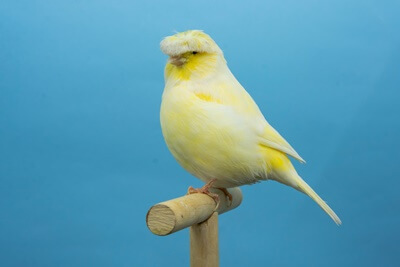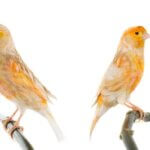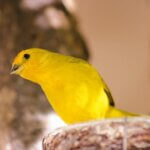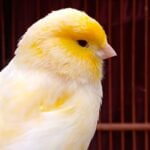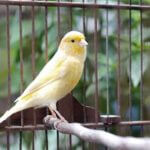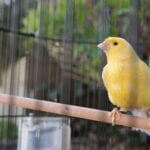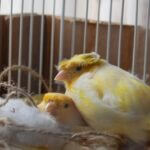The Gloster canary is recognizable by its short, stubby body and the flat tuft of feathers on top of its head, which makes it seem like it has a bowl cut.
These birds don’t occur naturally in the wild since they result from selective breeding. They were originally bred in Gloucester, England, in the early 1920s, hence their name.
During the 1960s, they were imported to the U.S., where they quickly became popular, largely due to their impressive singing abilities.
Unlike most wild canary varieties, Gloster canaries have a naturally friendly temperament, largely because they’re all raised in captivity.
Their docile temperament, beautiful singing, and low care requirements make them ideal pet birds.
Gloster Canary Overview
The Gloster canary (serinus canarius domesticus), or Gloster fancy canary, is a small songbird from Gloucester, England. The two main types of Gloster canaries are as follows:
- Coronas
- Consorts
Gloster coronas sport the “bowl-cut” (crested) appearance due to the flat feathers that adorn the top of their heads.
Gloster consorts don’t have a crest on their heads. Apart from this obvious difference in appearance, the body types of these two birds are virtually identical.
Temperament
Gloster canaries are selectively bred and don’t occur naturally in the wild. So, they tend to be more docile and less prone to aggression or snappy behavior.
This is why they make such great pet birds for beginners and children. Of course, experienced bird owners can also enjoy the even temperament.
However, they’re best kept as cage birds to watch and listen to. Nevertheless, Gloster canaries are active birds that love to play with toys and will keep their owners entertained for hours.
Male Gloster canaries are territorial. Keeping more than one in a single cage might result in frequent fights. So, if you’re planning on keeping multiple males, you should have separate cages for each.
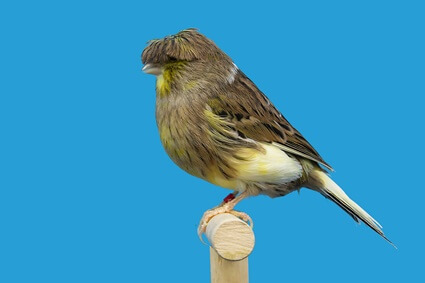
Speech and Vocalizations
Although not as prolific singers as other canary varieties, Gloster canaries can produce some of the most melodious and soothing sounds. Males are better singers than females and tend to vocalize more frequently, whereas females are quieter.
Gloster canaries aren’t very loud, making them ideal pets if you live in an apartment. While their singing is enjoyable to listen to, you’ll have to wait for your pet to mature before it develops its song.
How Long Do Gloster Canaries Live?
The average lifespan of a Gloster canary is about 7-10 years. However, if you give them adequate care, they can live up to 12 years.
Since they are selectively bred, Gloster canaries don’t suffer from many genetic deformities. In most cases, their ailments result from poor nutrition and living conditions.
Gloster Canary Genetics
Gloster canaries don’t occur naturally in the wild.
Instead, they’re a selectively bred variety derived from breeding the following:
- Border Canary
- Roller Canary
- Small Crested Canary
According to Biological Sciences, border canaries are selectively bred for their plumage and complex songs. Meanwhile, roller canaries are bred for their simple low-pitched songs.
The small crested canary provides the gene that gives Gloster coronas their iconic bowl-cut look.
A dominant gene causes the crested mutation in Gloster canaries. However, a double dose of the same gene can be fatal.
If a chick inherits the gene that causes crested mutation from one parent, it develops a crest. If it inherits the crested gene from both parents, it will likely develop skull deformities.
Most birds that inherit crested genes from both parents die in their shells. For this reason, Gloster canary breeders often avoid pairing two Gloster coronas together for breeding. Instead, Gloster coronas are usually paired with consorts (plain heads).
Gloster consorts lack the gene that causes crested mutation. So, they can be paired together without any adverse effects on the resulting offspring.
What Does A Gloster Canary Look Like?
While Gloster canaries are mainly known for their meme-worthy crest, they have various physical traits that set them apart from other canary varieties.
Here is an overview of a Gloster canary’s appearance:
Size
One of the main standout features of Gloster canaries is their short and stubby appearance.
On average, adult Gloster canary measures only about 4.5 inches (11.5 cm) and weighs between 12 and 29 grams. Gloster canaries also have an average wingspan of 7.8 to 9 inches (20 to 30 cm).
Color
Gloster canaries come in a wide variety of color combinations, including:
- White
- Yellow
- Frost
- Cinnamon
- Grey
- Green
This broad spectrum of colors is the direct result of variations in breeding.
How To Breed Gloster Canaries
Glosters mature sexually after about 8 months from their date of hatching. Even so, it is not uncommon for some birds to mature earlier (6 months) or later (up to 10 months).
Sexually mature males can be identified by their melodious singing and territorial behavior. Meanwhile, females exhibit nesting behaviors, such as collecting strips of paper and other materials to build nests.
If your canaries have reached sexual maturity, here’s how to prepare them for mating:
Trim Feathers Around The Vent
Gloster canaries have feathers around their vents, inhibiting the fertilization process during breeding.
Therefore, when preparing your birds for the breeding season, trim their feathers, as this will expose their reproductive organs sufficiently for effective breeding.
Hold your bird upside down with its head facing away from you and its chest facing upwards. Gently blow the feathers around the vent area to expose the cloaca. Then, trim the feathers using a pair of scissors.
When trimming the vent feathers on a male Gloster, be careful not to trim the guide feathers emanating from their vent.
Guide feathers direct the male’s sperm into the female’s cloaca during breeding to ensure fertilization.
Trim Nails
In addition to trimming the feathers around your canaries’ vents, it is also important to clip their nails when preparing them for breeding.
This allows them to perch properly and minimizes the chances of cracking eggs.
Be careful not to cut the vein when clipping your bird’s claws. Otherwise, this will cause bleeding. You should trim at least 2 centimeters below the vein.
Once you’ve trimmed both canaries’ vent feathers and nails, you must put them in a cage with a grill partitioning. This allows your canaries to get acquainted with each other.
During this time, the female will start building a nest in anticipation of breeding. You should put some nesting material inside the female canary’s side of the cage.
Healthy Diet And Water
When preparing your Gloster canaries for breeding, ensure they receive a nutrient-rich diet and fresh water. Not only does this allow the female canaries to compensate for the nutrients they expend during breeding, but it ensures there’s enough nestling food for the fledglings once they hatch.
Some of the best foods to offer breeding canaries include:
- Pellet food
- Seed mixes
- Egg food
- Soft food
You should also provide cuttlebone to boost your birds’ calcium intake. This promotes the development of healthy eggs.
According to the Turkish Journal of Agriculture, consumption of stale or contaminated food affects a canary’s health and singing capabilities.
Signs of Peak Condition for Breeding
Breeding in Gloster canaries usually happens during spring. These birds prefer to breed when the environmental temperature is about 70 degrees Fahrenheit.
There should also be a minimum of 14 hours of light. So, try replicating these conditions in your aviary using artificial lights and lamps.
When the birds are ready to breed, they’ll exhibit certain signs. Females usually add nesting materials into their nests, while males tend to sing more loudly and melodiously.
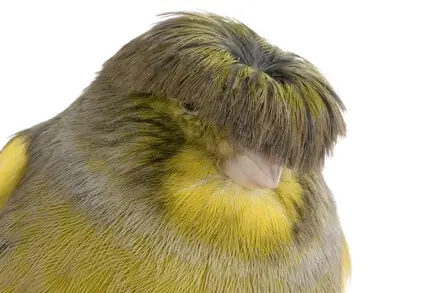
Remove Cage Partition
Once your canaries are ready for breeding, remove the partition separating the sexes to allow them to mate. Check the nest regularly to see if your female bird lays any eggs.
Remove each successive egg from your birds’ nests and store them until the females stop laying for that breeding season. Not only does this create space for more eggs, but it minimizes the risk of breakages.
Once your females stop laying eggs, return the laid eggs to the nests so that the birds begin the incubation process.
How Long Do Gloster Canaries Take To Breed?
On average, a female Gloster can lay 4-5 eggs during a single brood at intervals of 1 per day. However, it’s not uncommon for canaries to lay up to 8 eggs during a single brood.
It takes about 14 days for canary eggs to hatch into fledglings; this is counted from the day the female sits on the eggs (starts incubating them) rather than from the day they’re laid.
Are Gloster Canaries Good Pets?
Gloster canaries aren’t only visually striking with their beautiful colors and impressive crests but also capable of producing melodious tunes.
They’re not as loud or disruptive as other canary varieties and birds. This makes them perfect pets if you live in an apartment or other shared living arrangement.
Moreover, they have a docile personality and are less likely to bite, so even young kids can handle them (with adult supervision, of course).
They have minimal care requirements and are comparatively inexpensive, making them ideal pets for beginners and experts alike.

